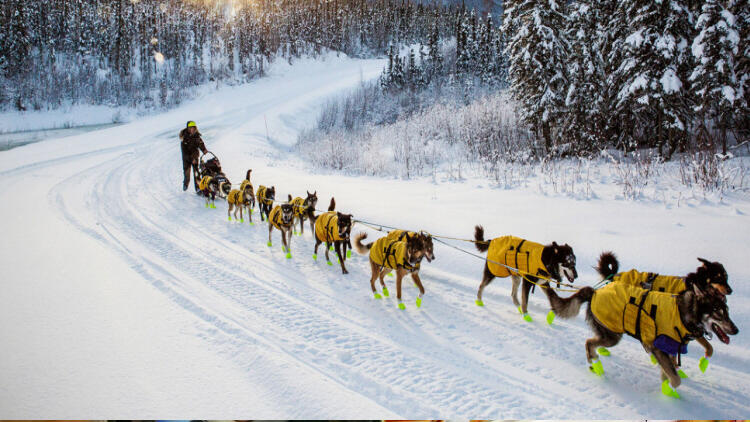drop longtime conflict photographer Katie Orlinsky in the middle of any “big bad capital city” and she says she’ll be just fine. But working in “middle of nowhere, Alaska,” presents a different set of challenges. Last year she photographed the Yukon Quest Sled Dog Race for the first time and experienced the coldest weather of her life, making her wonder how she could continue working. Orlinsky returned to cover the race again this year for National Geographic News, and was more confident working in extreme weather conditions—but this year the temperatures dropped to minus 50°F—30 degrees colder than last year. Orlinsky shared some of her most memorable experiences from this year’s race with us: Riding in a charter plane with 16 sled dogs, drinking the infamous sourtoe cocktail, and learning the true meaning of going with the flow. MALLORY BENEDICT: Not many people can say they’ve been on a plane with 16 sled dogs. What was that like? KATIE ORLINSKY: I ended up sharing a charter plane [sitting in front with the pilot] with two of the scratched dog teams. It was pretty surreal. I was in heaven, since I have dreams of being surrounded by dozens of dogs in a warm, cozy space. But the decision to fly the dogs out of a race is practical, and oftentimes quite sad, since it usually means someone on the team, dog or human, has gotten hurt or worn down, or that an entire team has scratched from the race. It’s amazing—we fit three people, 16 dogs, two sleds, and all our stuff into this one small plane. MALLORY: Many of the checkpoints along the route have their own quirks and surprises. Can you tell us about one of your weirdest experiences at a checkpoint? KATIE: [The bartender who calls himself] Captain Dick Stevenson, AKA Captain River Rat, sits at the Downtown Hotel Bar in Dawson City in Yukon, Canada, every night at a booth where he serves the “sourtoe cocktail.” It’s a ten-dollar drink with an actual frostbitten, petrified, human toe in it. There are strict rules for drinking it: your lips have to touch the toe, and you have to finish the whole drink. If you swallow the toe you have to pay a fine of $2,500. There’s a lot of mystery and myth around how the toe cocktail started, but it’s definitely a big part of the tradition in Dawson City. Last year, I bought one for someone so I could take a picture of it. This year I knew I had to have one myself. It was exactly as gross as you’d expect. MALLORY: How are the relationships between the mushers? Are they competitors or comrades? KATIE: There’s a little bit of both. Top mushers are definitely competitive—Brent Sass and Allen Moore race to win—but as people they are still friendly and collegial with each other. Some mushers are actually very close friends; they race with each other’s dogs on their teams and train each other’s puppies. There are a number of married musher couples too, where one spouse races the Yukon Quest and the other the Iditarod. Mushers also sometimes rescue and save each other’s lives out on the trail or they team up and race close together when conditions are really rough in order to keep an eye out for one another. This year, Lance Mackey, one of the most accomplished mushers of all time, was running a team of puppies, which kept him near the back of the pack, and he ended up spending most of his time alongside a rookie musher who was doing her first ever long dogsled race, Kristen Knight Pace. He later said it was the most fun he’s ever had in a race. MALLORY: What do you love most about photographing the dog sledding culture and the extreme races that go along with it? KATIE: The races are just one part of the story, but the larger narrative of sled dog racing and dog mushing culture in general is what I am most interested in and inspired by photographically. This project is completely different than anything I have ever done before, and it’s a lot of fun. Yet it’s also a lot more challenging than I expected. It’s a whole different kind of skill set for working in this region, especially alone. I like challenges though. MALLORY: What do you do to prepare for covering this type of story? Any physical or mental preparations? KATIE: You can prepare as much as humanly possible and then the weather doesn’t cooperate or a machine breaks or the car stops or the story completely changes because the musher you were following drops out —then none of it really matters. It is all so unpredictable. So mentally speaking, just being prepared that anything can happen is your best bet, and trying to keep a positive attitude when things don’t go as planned. (National Geographic)



















